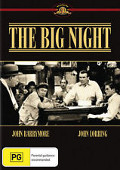
Directed by
Joseph Losey
75 minutes
Rated PG
Reviewed by
Bernard Hemingway

The Big Night
To describe Joseph Losey's last film in America before his HUAC-inspired move to Europe as a teen melodrama is rather misleading for although it concerns one night in the life of a troubled teen there is as yet no evidence of the teen perspective (which would be inaugurated by The Wild One which was still two years away). This is most directly demonstrated in the wardrobe of the young central character who when he heads off on his night's odyssey dresses in typical adult attire (and the music which is used prominently, is jazz). Rather, The Big Night is stylistically much closer to the sociological/film noir style of films like The Set-Up (1949) a combination beautifully captured in the opening credits. It might well however be described as “proto-teen” and cinematographer Hal Mohr who is responsible for its most distinctive aspect (the credits proudly announce that it was filmed using the “Garuttso Balanced Lens”), went on to film The Wild One.
As a production the film is B grade in tone, most of it being shot on a cheap sound stage. The script, based on the novel Dreadful Summit by Stanley Ellin and co-written by Ellin and Losey, is rather turgid and the cast largely made up of stock players. John Barrymore Jr., son of John and father of Drewe, plays George La Main, a bespectacled square whose father runs a crummy bar. On the night of his 17th birthday when he is supposed to go to the fights with his Dad and the latter’s girlfriend, sportswriter, Al Judge (Howard St. John) turns up at the bar and gives Dad a caning without him resisting. George is upset at what he perceives as his Dad’s lack of manliness and decides to revenge himself on Judge. So begins his big night and his learning of a few life lessons.
The auteurial hand of the director is often visible, resulting in a certain slippage in the relation between dramatic realism and visual symbolism. The result is, as is always the case with Losey a tendency to awkardness but in this case suits the subject matter In this respect too, Barrymore, because of his spotty nerviness, is well cast although no James Dean and the film remains of some interest as a harbinger of things soon to come.
Available from: Shock Entertainment
Want something different?





